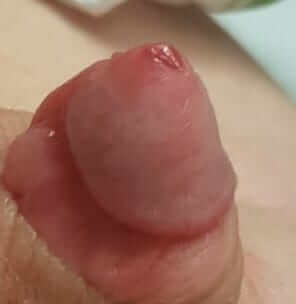
Meatal stenosis
This is a very important post, written in collaboration with a great pediatric urologist – Dr. Dudi Ben Meir (this is a link to his website). In the last couple of years I sent to his clinic many patients who got a recommendation for operation for treatment of meatal stenosis. In many cases there was no conclusive recommendation for surgery, and most patients managed fine without it.
This medical condition where the opening of the penis is narrow and obstructed is called meatal stenosis.
How does meatal stenosis develop?
Meatal stenosis could be a congenital situation, due to a malformation existing from birth. This is not a common situation. However, the goal of this post is to learn more about the more common condition, the acquired one.
Acquired meatal stenosis is caused by a “chemical” inflammation in the area, as a result of exposure to materials like Ammonia, which is secreted in the urine. A possible cause for meatal stenosis is when the opening of the urethra is over-exposed to diapers with urine, causing inflammation and stenosis formation. Though it can be a long term complication of circumcision (since the foreskin is removed and the tip of the penis is rubbing against the diaper), there is no correlation between the method and way preforming the procedure, and developing meatal stenosis. You can also read more of other medical aspects of circumcision in this link.
In the photo attached you can see the inflammation in the area, where the opening of the urethra is very red.
Later on, when there is stenosis developing, the flow of the urine becomes very thin and the urination time is prolonged. Many doctors relate a strong flow during urination to this stenosis and even suggest it as an indication for surgery. This is not necessary true, since normally the urination flow in children is long and strong, as is the abdominal pressure needed for urination and a strong muscle in the urinary bladder.
Can this inflammation be prevented?
Certainly. I suggest for anyone still changing diapers, to look at the tip of the penis while changing and if you see any redness in the area, put a bit of the diaper cream on the urethral opening.
Don’t worry, the opening will not be obstructed with cream (don’t put a lot of cream, just a little bit), and the baby will continue peeing happily ever after.
The cream in the area will stop friction and prevent inflammation.
What does meatal stenosis cause?
Stenosis will cause a low urine flow and a prolonged urination time. It is not painful, and does not cause a deviation in urination as you will read ahead.
What does meatal stenosis does not cause?
Some boys, who are in the middle of potty training, are having trouble directing the urine into the toilet, since the urine flow is deviating upwards. In these cases, a membrane could be observed, covering the urethral opening in the lower part (meatal web). This membrane causes the urine flow to deviate upwards, and may cause some of the boys to sit while urinating to keep the urine in the toilet and not around it. In many of these cases, there is no meatal stenosis and the urination flow is regular.
I want to distinguish between two very confusing conditions. The first is meatal stenosis. The second is that membrane.
In the words of Dr. Dudi Ben Meir – “with years and experience, I’ve learned that there is not necessarily a connection between the appearance of the meatal opening, looking “constricted” and a true stenosis. So, there is a need to watch the boy urinate and not just looking at the urethral opening for a correct diagnosis and a insuring a true need for surgery”.
Most boys referred with meatal “stenosis” were referred because of a stenotic appearance. Only some of those children truly have a thin urination flow, causing prolonged urination. Most of the time there is no symptoms of pain in meatal stenosis (as opposed to stenosis due to surgery or catheter insertion), unless there is an active inflammation of the area (meatitis).
What are the indications for surgery?
The indications for surgery are:
– Stenotic appearance of the urethral opening with a thin urination flow noticed while the child is urinating.
– A deviation of the urine flow while holding the penis and directing it into the toilet, caused by the membrane mention before (with or without meatal stenosis).
What exactly happens in the procedure?
The surgery itself is very short and simple. It is usually done under short-term anesthesia. In the operation the opening of the urethra is cut open or the excess membrane is removed. After the dissection, the opening must be spread a part so it will not close again, it is usually not painful and children can return to normal activity in the following day.
What is the conclusion from tis post?
There are some medical conditions where the indication for surgery is not conclusive, but relative and not clear. In these cases many children are being operated without a true cause, just to fill the operation rooms in medical centers. I suggest all parents to go and see a true pediatric specialist before deciding on an operation.
If a pediatric expert with no economic agenda in the case, says there is need for surgery, that go and do the procedure with no worries at all.
Good luck!
For comments and questions, please register
